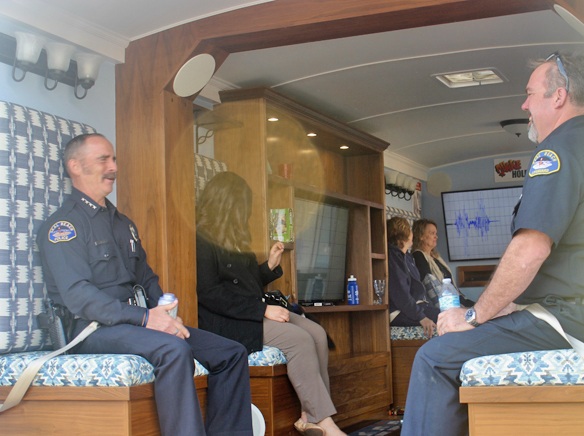
The Seal Beach Police Department parking lot played epicenter to a recent “earthquake.”
An earthquake simulator known as the “Big Shaker” visited the department last week allowing City of Seal Beach officials, emergency responders and others to experience what a 6.7 magnitude earthquake feels like.
The “Big Shaker” is a mobile simulator that looks like a typical living room. It seats up to six adults, is 24 feet long, weighs 8,000 pounds and has a specialized hydraulics system “specifically engineered to simulate varying degrees of earthquake intensity.” When seated inside the simulator, participants are rocked by severe shaking that sends glassware toppling off shelves and loose items like stuffed animals flying.
The earthquake simulation was just one part of the Seal Beach Police Department’s “Table-Top Exercise,” an annual event that focuses on the city’s emergency preparedness. Earthquake preparedness was the focus of this year’s half-day event which took place on Wednesday, Jan. 30. Around 75 people participated in the exercise including City Manager Jill Ingram and other city staff, Police Chief Joe Miller, representatives from the Orange County Fire Authority, Naval Weapons Station Seal Beach, the Los Alamitos Unified School District and emergency personnel and volunteers.
The exercise started with a presentation from Margaret Vinci, Manager of the Office of Earthquake Programs at Caltech.
“We will have another major earthquake,” Vinci said and emphasized that Southern California is overdue for such an event especially along the San Andreas fault.
In her talk, Vinci warned about possible hazards a large earthquake would pose to Seal Beach. A top threat is liquefaction, which, according to the United States Geological Survey occurs when “saturated sand and silt take on the characteristics of a liquid during the intense shaking of an earthquake.”
When liquefaction happens beneath buildings and structures, it can be a destabilizing force that can cause major damage.
Vinci also spoke about how an intense earthquake could greatly impact people’s access to water since many pipes will be destroyed by the shaking. “Water is key,” she said and encouraged people to have their own supply of drinking water at home and in their cars.
Fire was another hazard Vinci spoke about. In her scenario of the “big one” hitting Southern California, she estimated 1,600 ignitions of fires.
Vinci said people having their own small fire extinguishers could be key in helping stop fires from spreading in the aftermath of a major earthquake.
Vinci said residents can better prepare their homes to withstand a strong earthquake with a retrofit which involves bolting the house to its foundation. More information on that is available at www.earthquakebracebolt.com.
She also advised people to be prepared to be on their own without help from emergency responders for seven to ten days after a significant earthquake.
“I think the biggest thing is for people to get their own home and business in order,” Cpl. Brian Gray, Emergency Affairs Coordinator for the Seal Beach Police Department wrote in an email following the exercise. “First Responders are going to be stretched very thin immediately following a large-scale incident, so the more everyone can do as an individual, a family, or even a neighborhood to be as self-sufficient as possible, the better.”
The exercise also featured facilitated discussions between City staff and other stakeholders on how to better prepare for a disaster.
“We came up with a lot of great points, both for future exercises as well as real life incidents that we are going to work on collectively moving forward,” Cpl. Gray said.











